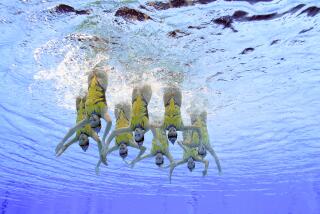Exercisers Are Taking a Different Kind of Walk--in 3 Feet or More of Water
- Share via
Water walking.
Admittedly, the term inspires jokes. But before you dismiss this particular fitness activity, consider that it may be the easiest, most enjoyable way yet to shape up.
Water walking is not to be confused with water jogging, which made a brief splash in pools across America in the early 1980s. In that pursuit, joggers, supported by life jackets or life belts, “run” in water over their heads.
Water walkers don’t even have to get their faces wet, and they don’t need any special equipment. All they do is walk in water thigh- to chest-deep.
When it’s done for 20 minutes at least three times a week, water walking can provide the same rewards offered by by walking or jogging on land--improved muscle tone, heart health, and calorie-burning (up to 460 per hour). And water walkers don’t sweat or risk injuries.
Unlike swimming, water walking allows you to talk to the person next to you while “you forget you’re exercising,” said Pam Bishop, aquatics director of the Cleveland County Family YMCA in Norman, Okla., the birthplace of waterwalking.
Began With Therapy
Water walking is safe even for people with physical limitations such as arthritis, heart disease or high blood pressure, because the water supports about 90 percent of the body’s weight. Some people who are not able to walk comfortably on land find they can in water.
According to Walking Magazine, all water exercise, including water walking, has its origins in rehabilitation programs for injured athletes.
“Once coaches started using water for their injured athletes, usually runners, others began to show interest,” writes reporter Laurie Einstein Koszuta. “It didn’t take long for weary aerobic dancers and ardent joggers to realize that exercising in water could not only relieve their joint aches and pains but that it could also maintain their fitness levels.”
Two men are credited with promoting water walking: John Spannuth, formerly the senior aquatics director of the Cleveland County Family YMCA, and Dee Moscoe.
Spannuth first thought of water walking as an exercise activity 2 1/2 years ago while he was watching Moscoe diligently walking to and fro in the YMCA pool. Moscoe began water walking, he told Spannuth, because arthritis in his knees was so bad that walking on land had become very painful. Water walking four to five times a week, Moscoe said, kept his joints flexible, his muscles toned and his energy high.
Classes, Conferences
That was all Spannuth needed to hear. He set up water walking classes and conferences, and he founded a national water fitness association.
An article in Walking Magazine last September brought more attention. Today, more than 2,500 people water walk every week at the Cleveland County YMCA.
Said Moscoe, who is 72: “It keeps me going. At this age I have the tendency to be sedentary. I look forward to my daily bout with the water.”
For do-it-yourselfers, Spannuth recommends that you always start with a warm-up, perhaps 3 to 5 minutes of walking slowly in the water. “Then increase the intensity and speed to the point that it feels vigorous without being exhausting,” he says. Maintain that pace for 20 to 30 minutes. To cool down, slow the pace for a few minutes to allow your heart rate to return to normal.
For a total-body workout, Spannuth recommends walking in water at least waist deep, with chest-deep the ideal. Swinging the arms underwater will work the upper body, he says. The other advantage of walking in water that deep is that “the whole body is gently massaged as it works against the water’s resistance,” Spannuth said. Further, according to research at the Nicholas Institute of Sports Medicine in New York, the number of calories burned increases with the depth of the water.
Some fitness experts disagree with those views, however, saying that thigh-deep water is deep enough to provide significant health benefits for the water walker.
Where to Do It
Water walking can be done in any size pool, although one with a long, straight shallow area is ideal. For a small pool, Spannuth suggests two alternatives: “Either walk back and forth in the available walking area, alternate turning to the right or left each time you turn; or use a flotation device around your waist and walk in shallow water as far as you can and then deep water walk to the end of the pool.”
To vary the movements, try walking backward or sideways; alternate short, quick steps with long ones, or try something fancier such as stepping with one foot and kicking with the other or touching each knee with the opposing hand or elbow.
Although water walking is considered a very safe exercise, it does require some physical exertion, so be sure to pay attention to any warning signals. These might include abnormal heart action, dizziness or nausea. Consult your doctor should any such symptoms continue after you rest.
For more information about water walking or to find a class, write to the National Water Fitness Assn., P.O. Box 360133, 9851D Military Trail, Boynton Beach, Fla. 33436.


